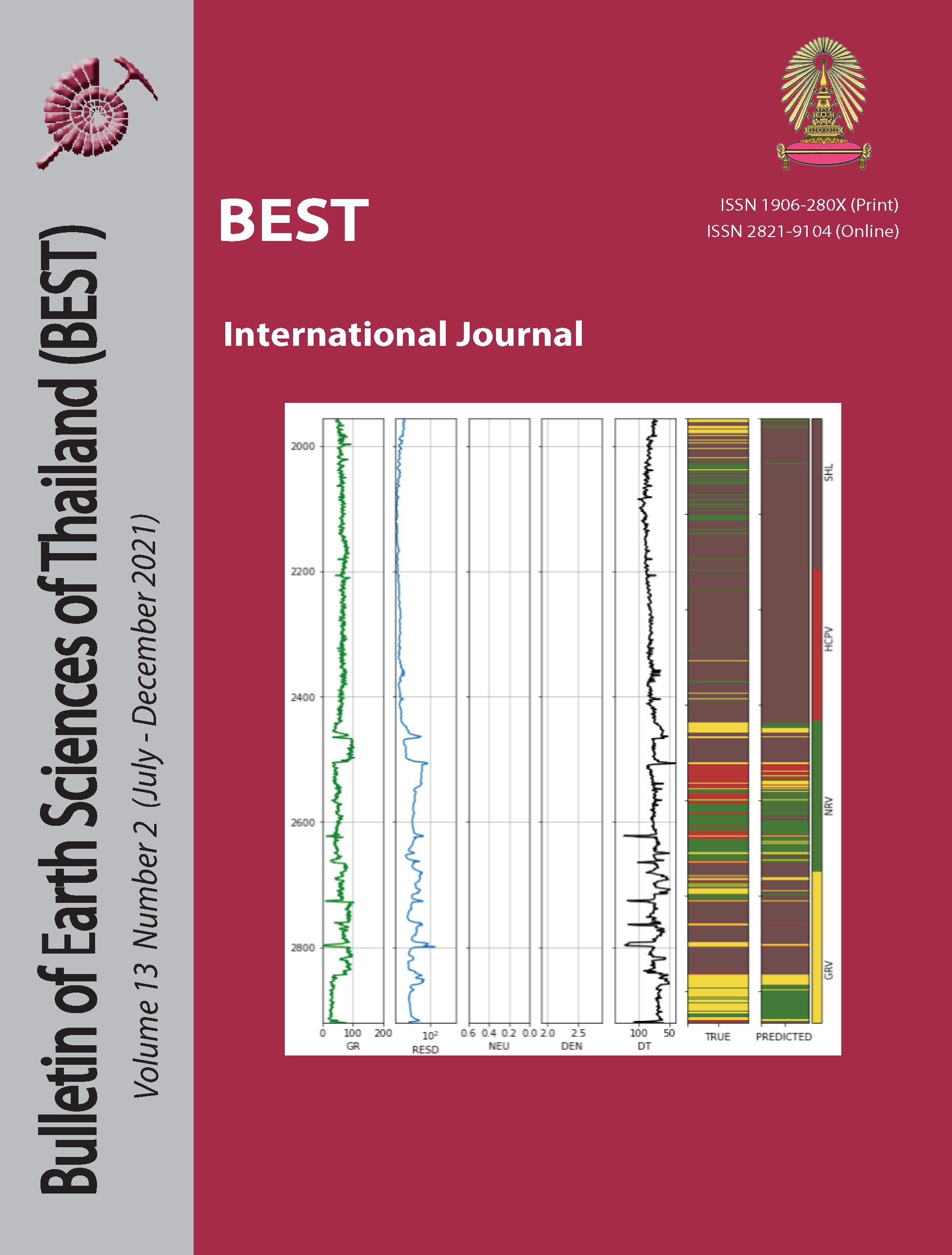Extensional Fault Systems in Mae Moh Basin, Lampang province, Thailand, based on 3D Seismic Data
Main Article Content
Abstract
The Mae Moe Basin is a major NE-SW trending failed rift basin on the remnants of the Sukhothai Arc of Northern Thailand. The Cenozoic sediments of the basin have been significantly displaced by syn-rift and post-rift deformation and erosion, which make for a labyrinthine of basin structures. In this paper, the preliminary research results of the Mae Moh mine based on 3D seismic data will be presented. The anisotropic nature of the Mae Moh mine strata seems to play a crucial role in the fault geometries present. The architectures present in the Mae Moh mine 3D seismic data show two different fault systems. The first fault system shows evidence of a variable west-northwest strike direction normal faults. The second fault system indicates normal faults linking with low-angle listric faults. Both fault systems offer evidence of linkage causing sigmodal geometries to be present in map view and show correlation through seismic attributes and horizons.
Article Details

This work is licensed under a Creative Commons Attribution-NonCommercial-NoDerivatives 4.0 International License.
Copyright © 2008 Department of Geology, Faculty of Science, Chulalongkorn University. Parts of an article can be photocopied or reproduced without prior written permission from the author(s), but due acknowledgments should be stated or cited accordingly.
References
Ackermann, R. v., R. W. Schlische, and M. O. Withjack, 2001, The geometric and statistical evolution of normal fault systems: An experimental study of the effects of mechanical layer thickness on scaling laws: Journal of Structural Geology, v. 23, no. 11, p. 1803–1819.
Chantraprasert, S., and S. Utitsan, 2021, Origin of synchronous extension and inversion in a rift basin: The Phitsanulok Basin, central Thailand: Journal of Asian Earth Sciences, v. 213, no. October 2020, p. 10477.
Corsiri, R. and Crouch, A. 1985. Mae Moh coal deposit: geological report. Thailand-Australia Lignite Mines Development Project. (unpublished).
Corti, G., 2012, Evolution and characteristics of continental rifting: Analogue modeling–inspired view and comparison with examples from the East African Rift System: Tectonophysics, 522–523, pp. 1–33,
Dew, R. E. C. et al., 2018, Probing into Thailand’s basement: New insights from U–Pb geochronology, Sr, Sm–Nd, Pb and Lu–Hf isotopic systems from granitoids: Lithos, v. 320–321, no. July 2019, p. 332–354.
Lacassin, R., Maluski, H., Leloup, P.H., Tapponnier, P., Hinthong, C., Siribhakdi, K., Chauviroj, S., Charoenravat, A., 1997. Tertiary diachronic extrusion and deformation of western Indochina: Structure and 40Ar/39Ar evidence from NW Thailand. Journal of Geophysical Research 102 (B5), 10013–10037.
McClay, K.R., Dooley, T., Whitehouse, P., Mills, M., 2002. 4-D evolution of rift systems: insights from scaled physical models. American Association of Petroleum Geologists Bulletin 86, pp. 935–960.
Metcalfe, I., 2002. Permian tectonic framework and palaeogeography of SE Asia. Journal of Asian Earth Sciences 20, 551–566.
Morley, C. K., and N. Wonganan, 2000, Normal fault displacement characteristics, with particular reference to synthetic transfer zones, Mae Moh mine, Northern Thailand: Basin Research, v. 12, no. 3–4, p. 307–327.
Morley, C. K., and R. Westaway, 2006, Subsidence in the super-deep Pattani and Malay basins of Southeast Asia: A coupled model incorporating lower-crustal flow in response to post-rift sediment loading: Basin Research, v. 18, no. 1, p. 51–84.
Morley, C. K., C. Haranya, W. Phoosongsee, S. Pongwapee, A. Kornsawan, and N. Wonganan, 2004, Activation of rift oblique and rift parallel pre-existing fabrics during extension and their effect on deformation style: Examples from the rifts of Thailand: Journal of Structural Geology, v. 26, no. 10, p. 1803–1829,
Morley, C.K., 2013. Discussion of tectonics models for Cenozoic strike-slip fault–affected.
Morley, C.K., 2015. Five anomalous structural aspects of rift basins in Thailand and their impact on petroleum systems. In: Richards, F. L., Richardson, N. J., Rippington, S. J., Wilson, R.W. & Bond, C. E. (eds), Industrial Structural Geology: Principles, Techniques, and Integration. Geological Society, London, Special Publications, 421.
Polachan, S., Pradidtan, S., Tongtaow, C., Janmaha, S., Intarawijitr, K., Sangsuwan, C., 1991. Development of Cenozoic basins in Thailand. Marine and Petroleum Geology 8, pp. 84–97.
Rhodes, B.P., Perez, R., Lamjuan, A., Kosuwan, S., 2002. Kinematics of the Mae Kuang Fault, Northern Thailand Basin, and Range Province. The Symposium on Geology of Thailand, Bangkok Thailand, August 2002, pp. 298–308.
Schlische, R. W., and M. O. Withjack, 2009, Origin of fault domains and fault-domain boundaries (transfer zones and accommodation zones) in extensional provinces: Result of random nucleation and self-organized fault growth: Journal of Structural Geology, v. 31, no. 9, p. 910–925.
Sompong, W., Springbett G.M. and Evans P.R. 1996. Mae Moh coal deposit: Geological report. Thailand-Australia lignite mines development project (unpublished).
Sone, M., and I. Metcalfe, 2008, Parallel Tethyan sutures in mainland Southeast Asia: New insights for Palaeo-Tethysclosure and implications for the Indosinian orogeny: Comptes Rendus - Geoscience, v. 340, no. 2–3, p. 166–179. Charusiri, P., Daorerk, V., Archibald, D., Hisada, K., Ampaiwan, T., 2002. Geotectonic evolution of Thailand: A new synthesis. Journal of the Geological Society of Thailand 1, 1–20.
Tapponnier, P., Peltzer, G., Le Dain, A.Y., Armijo, R., 1982. Propagating extrusion tectonics in Asia: new insights from simple experiments with plasticine. Geology 10, 611–616
Uttamo, W., Elders, C.F., Nicols, G.J., 2003. Relationships between Cenozoic strikeslip faulting and basin opening in northern thailand. In: Storti, F., Holdsworth, R.E., Salvini, F. (Eds.), Intraplate Strike-slip Deformation Belts. Geological Society, London, Special Publication, 210, pp. 89–108.


